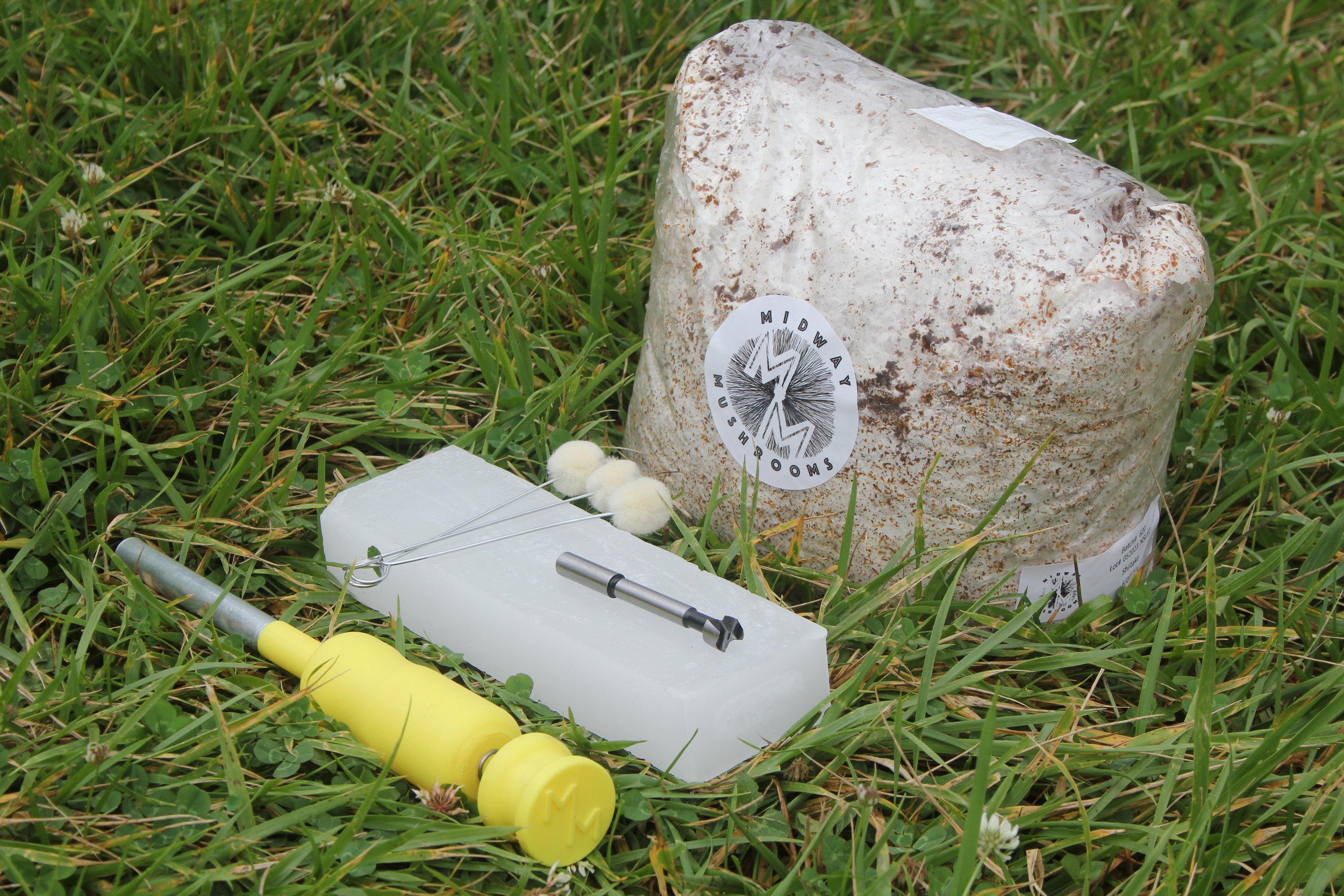from $30.00
Free shipping!
Log-based mushroom grow kits are a fun and easy way to cultivate large crops of gourmet mushrooms in your back yard! Our complete log grow bundle includes everything you need to transform fresh hardwood timber into tasty shiitake, oyster, or lion’s mane mushrooms. They make an excellent gift for mushroom nerds like us!!
A standard mushroom grow kit includes 1 mushroom log inoculation tool, 1 five-pound bag of sawdust spawn, 1 drill bit (5/8”), 1 pound of food-grade wax, and 3 wax daubers. (You’ll need to provide your own freshly harvested logs!)
Inoculation supplies are sold as a complete mushroom grow kit, as well as individually. Note that color will vary on your mushroom log inoculation tool.
How it works:
Wood-loving mushrooms such as oyster, shiitake, and lion's mane can be grown using several methods, each with its own advantages. Two common methods include the totem method, which involves stacking sections of logs with layers of spawn in between, and using filter patch bags filled with sterilized and inoculated substrate.
Yet among the various mushroom cultivation techniques, the log inoculation method remains a tried and true favorite for many mushroom growers. The process involves drilling holes in a log, filling these with sawdust spawn, and then sealing in the spawn to retain moisture and protect the live mycelium. This method often provides substantial yields for several years and requires little maintenance once the logs are inoculated, making it an excellent choice for both beginners and experienced mushroom grow kit users.
Once spawn has been introduced to the logs, and given the proper conditions, the mycelium colonizes the log by breaking down and consuming the wood. This results in the formation of a dense network of mycelium throughout the log, which is the vegetative growth stage of the mushroom.
When the log is fully colonized and environmental conditions are favorable, the mycelium will produce mushrooms, or "fruit," on the surface of the log. This process from inoculation to fruiting can take anywhere from six months to a year, depending on the mushroom species and environmental conditions. Despite the wait, the reward is substantial – namely the ability to harvest fresh, delicious, homegrown mushrooms right from your own backyard!
Click here for detailed step-by-step instructions on using your mushroom grow kit to inoculate logs for outdoor growth.
Available species:
Shiitake
The iconic shiitake mushroom (Lentinula edodes) is known worldwide for its meaty, smoky flavor and wonderfully chewy texture. This variety has been adapted for its delicious and comparatively tender caps, as well as for its striking speckled adornment!If you've only previously eaten shiitake from the supermarket, prepare yourself for a perhaps unexpected flavor dropkick straight to the tastebuds! Fresh, young shiitakes picked hours before off raw hardwood sawdust should be compared only metaphorically with the dried-out, imported specimens common in many American grocery stores.Native to eastern Asia and cultivated since ancient times for its culinary and medicinal properties, shiitakes are rich in protein, fiber, niacin, and a number of novel chemical constituents: the polysaccharides Lentinan and KS-2, for instance, have shown promise as potentially tumor-regressing, while the compounds arabinoxylane and eritadenine are suspected, respectively, to boost the immune system's natural killer cells and to help lower cholesterol. Shiitakes grow saprophytically, that is, on dead and dying trees, (especially on the "shii" tree within its native habitat! Aha!). Shiitakes are perhaps the most reliable, tried-and-true option for performing cultivation with a mushroom log inoculation tool.
Blue Oyster
The blue oyster mushroom (Pleurotus ostreatus) is a classic culinary staple beloved by many chefs for its intense meaty flavor. Resilient, productive, and forgiving of a relatively wide range of growing conditions, this particular strain produces large, stunning mushroom clusters the depth of whose vivid blue color scales inversely with temperature. Common across much of the temperate globe, including on our own Cumberland Plateau, where hardy specimens often can be found temporarily frozen solid during the winter months, white to tan oyster mushrooms of the same species grow saprophytically (on dead and dying trees), particularly in relation to hardwoods like oak and poplar. High in protein, vitamin C, niacin, and potassium, oyster mushrooms are healthy as well as profoundly flavorful. Fascinating, adaptable, and reliable, the blue oyster mushroom is a staple constituent of the mushroom cultivator’s toolkit.
Lion’s Mane
The lion's mane mushroom is an iconic toothed fungus that occurs naturally across much of North America. Its long, drooping spines are a unique feature of this mushroom. A spectacular seafood substitute that evokes the flavor and texture of crab meat, this otherworldly mushroom currently is the subject of extensive mycological investigation for its potentially neuroregenerative compounds; indeed, early studies suggest that several of its constituent compounds, particularly the “hericenones,” may help counteract age-related memory decline. Sometimes referred to as the bearded tooth mushroom, satyr's beard, or pom pom mushroom, lion’s mane has an extremely rich umami flavor with subtly sweet undertones. What’s more, its fresh, earthy smell can’t help but transport one’s imagination into a lush old-growth forest! Weird and wonderful, lion’s mane is a joy to watch grow (and to eat!).
Classic Oyster
It’s hard to go wrong with a tried-and-true classic! Ye olde oyster mushroom is a reliable crowd-pleaser with quick pin formation, generous cluster size, and tolerance for a relatively wide variety of environmental conditions. What’s more, its savory, meaty caps take on an exceptional umami flavor when pan-seared to a brown finish. Classic!
Please allow up to 3 weeks for processing time. Mushroom log inoculation tool and spawn bags are made to order!
Product:
Quantity:
Add To Cart









